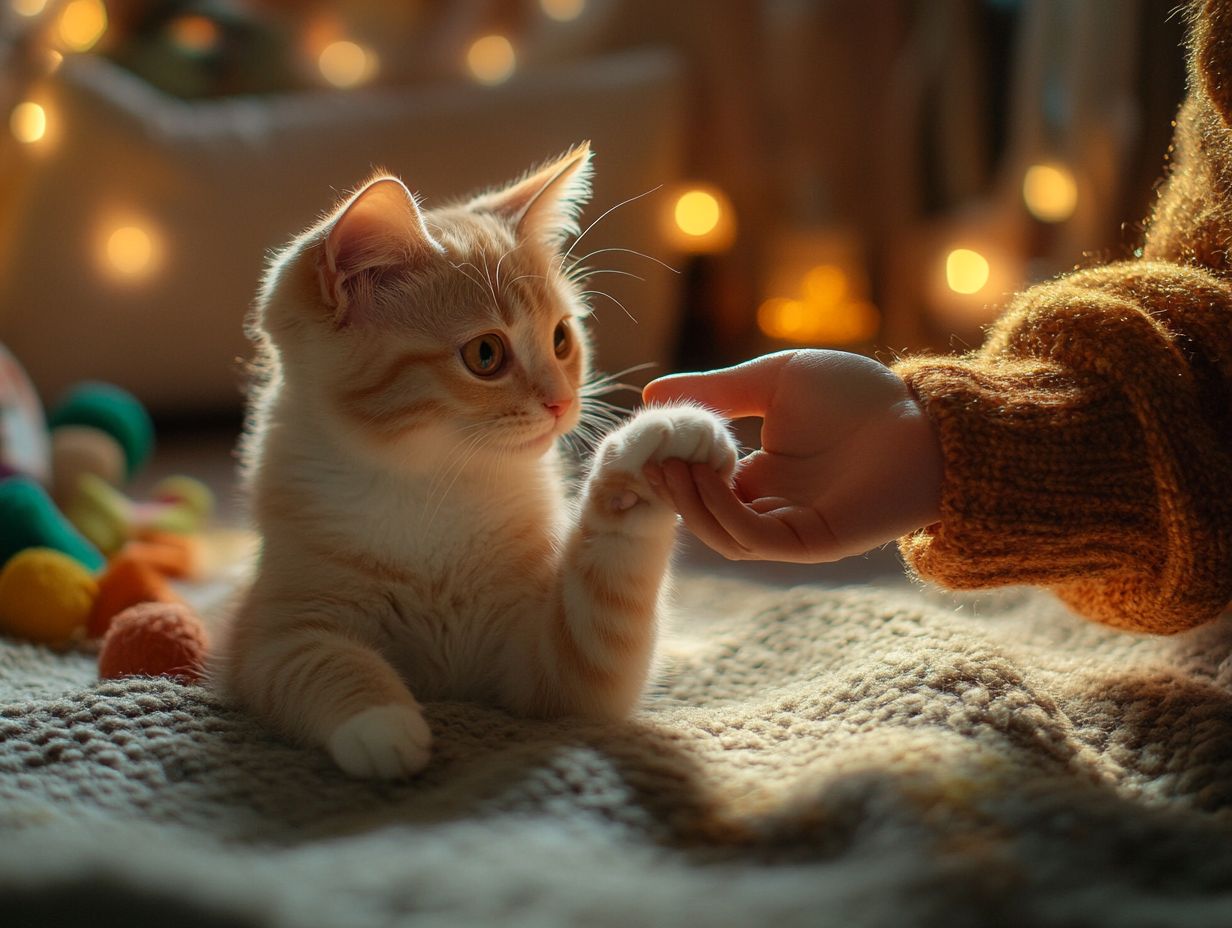Cats are fascinating creatures, but their biting behavior, including love bites and playful nips, can leave many pet owners puzzled and concerned. Understanding why your cat bites is essential not only for your safety but also for fostering a loving relationship.
This guide explores the common reasons behind cat bites, such as play aggression and petting aggression, how to recognize the signs of aggression, and effective prevention strategies. It also covers what to do if you get bitten and how to train your cat to redirect that energy.
Whether you’re a seasoned cat owner or new to feline companionship, this information will help you manage your cat’s behavior effectively through understanding cat language and biting triggers.
Key Takeaways:

- Understanding the common reasons for cat bites, including frustration and overstimulation, can help prevent them.
- Positive reinforcement and redirecting aggression are effective ways to train a cat to stop biting.
- Recognizing aggressive behavior and seeking professional help when necessary can ensure a safe and happy relationship with your cat.
Why Do Cats Bite?
Understanding why cats bite is important for cat owners and pet parents, as this behavior can arise from various reasons, including play aggression, petting aggression, and fear responses. This behavior can vary across different developmental stages, with kittens often biting during play due to their high energy levels, while older cats may bite due to pain or discomfort.
These behaviors are part of cat communication, helping them express discomfort, overstimulation, or even affection. Recognizing how a cat perceives overstimulation or fear can aid in fostering appropriate interactions and ensuring the safety of both the cat and its owner. It can help reduce the potential risks of injury associated with biting.
What Are The Common Reasons For Cat Bites?
The two most common reasons for cat bites are play aggression and petting aggression. Play aggression occurs when a cat exhibits its natural hunting instincts, while petting aggression often arises from overstimulation or frustration. Factors such as breed, genetics, and prior experiences can influence a cat’s biting behavior, with certain breeds known for higher play aggression.
These behaviors can be traced back to their ancestors, who relied on hunting and pouncing as essential survival skills. During play, felines may become overly stimulated and treat hands or toys as prey, leading to bites as they jump and bat at their target.
In contrast, petting aggression typically occurs when a cat reaches its sensory threshold and begins to feel discomfort or irritation. Frustration may also develop if the cat feels constrained or unable to express its natural instincts, resulting in biting as a response. Understanding these nuances in feline behavior can help owners foster a more harmonious relationship with their cats.
How To Prevent Cat Bites?
Preventing cat bites can be achieved by understanding feline behavior and implementing strategies such as environmental enrichment, suitable cat toys, and positive reinforcement techniques to promote appropriate interactions. Creating a calm environment can help mitigate stress and aggression in cats.
Utilizing interactive toys and engaging activities, such as puzzle feeders and feather wands, can help pet owners redirect their cat’s biting behavior, thereby decreasing the likelihood of bites and creating a safer home environment.
What Are The Signs That A Cat Is About To Bite?
The behavioral signs of an impending cat bite include changes in body language, stress indicators, and a potential fear-related biting response. Observing a cat’s posture can provide valuable insights; for instance, ears pinned back and a rapidly flicking tail are clear signs of irritation or discomfort.
Additionally, a cat that suddenly becomes still with dilated pupils may be in a heightened state of awareness, preparing to defend itself. Low growls or hisses from the pet are also warning signals that indicate the cat feels threatened. Recognizing these signs allows pet owners to create a safer environment and respond appropriately, thereby reducing the risk of a bite.
What To Do If Your Cat Bites You?
The first step following a cat bite is to assess the extent of the injury and any potential health risks, as cat bites can pose significant injury risks and health concerns. Proper treatment of cat bites may include:
- cleaning the wound
- monitoring for signs of infection
- consulting a veterinarian if necessary to ensure the well-being of both the cat and the owner
How To Treat A Cat Bite?

Moreover, understanding that biting is often a symptom of underlying issues encourages a thorough evaluation of the cat’s environment and health. Stress and anxiety can contribute to biting, so addressing these factors is crucial.
When To Seek Professional Help?
It’s important to recognize when a cat owner’s intervention is not enough. Indicators that professional assistance is necessary include persistent aggressive behavior, sudden changes in temperament, or biting that results in significant injury. Seeking help from a veterinary behaviorist or a certified animal trainer can provide guidance tailored to your cat’s needs.
Common Myths About Cat Bites
Many misconceptions surround cat bites, including the belief that all biting is aggressive. In reality, cats may bite during play, out of fear, or as a form of communication. Understanding this can help reduce unnecessary concern and foster better communication between you and your feline companion.
Conclusion
By incorporating positive reinforcement training methods, monitoring environmental stressors, and respecting your cat’s boundaries, you can mitigate biting behavior. Ongoing learning about feline behavior and communication will strengthen the bond you share with your cat and promote a safer environment for both of you.
Proper care of a cat bite is essential to reduce the risk of injury and ensure the overall health of the cat. This care includes cleaning the wound, applying antiseptic, and consulting a veterinarian if signs of infection appear. According to the American Veterinary Medical Association, timely treatment can prevent complications.
First, gently clean the bite area with warm water and mild soap to remove any dirt and bacteria. After rinsing thoroughly, pat the wound dry with a clean cloth. Next, apply an antiseptic solution or ointment that is safe for cats to help prevent infection. Be mindful that a cat’s emotional state can influence their biting; stress from environmental changes or social dynamics can trigger such behavior.
Carefully monitor the wound for any signs of redness, swelling, or discharge, as these may indicate an emerging infection. If these symptoms occur, or if the cat exhibits unusual behaviors such as lethargy or loss of appetite, seek veterinary attention promptly. A veterinarian can provide guidance on ensuring the cat’s swift recovery. Additionally, a veterinarian may help rule out any underlying medical issues contributing to the biting behavior.
When Should You Seek Medical Attention?
You should seek medical attention if a cat bite shows signs of infection, such as increased redness, swelling, or oozing pus. Additionally, if the bite is deep or located in high-risk areas like the hands or face, where there is a greater chance of deeper injury and functional loss, prompt care is essential. Increased pain at the injury site, as well as the development of fever and chills, are concerning signs that may suggest an infection requiring medical attention.
Cat bites can introduce bacteria that lead to infections like cellulitis, which can progress rapidly if left untreated. Medical treatment is crucial not only for managing the injury but also for protecting the overall cat population through vaccinations and other preventative measures, ensuring appropriate wound care.
How To Train Your Cat To Stop Biting?
Teaching a cat not to bite involves using behavior modification techniques that emphasize positive reinforcement and promote appropriate interactions. These strategies encourage behaviors other than biting, ultimately fostering a peaceful home environment. Consider the cat’s individual traits, as each cat may respond differently to various training methods.
What Are The Best Ways To Train A Cat? Training Success and Behavior Modification
The most effective ways to train a cat involve using consistent training techniques, particularly positive reinforcement methods like clicker training. This approach not only aids in behavior modification but also strengthens the bond between cats and their owners. Kittens may require different strategies compared to adult or senior cats, as their experiences shape their behaviors.
Clicker training allows cats to learn by associating positive outcomes with desired behaviors, establishing clearer communication pathways between the pet and the trainer. To enhance the effectiveness of training, it’s beneficial to incorporate a variety of strategies, such as target training, which keeps sessions stimulating and provides additional mental challenges for cats. Providing rewards, such as treats, praise, or playtime, can be motivational.
Generally, by regularly conducting short, enthusiastic, and rewarding training sessions, owners can observe significant improvements in their pets’ behaviors, contributing to a more pleasant home environment.
How To Use Positive Reinforcement To Stop Biting?
Positive reinforcement is an effective way to stop a cat from biting by rewarding them for behaviors that you want to encourage instead of biting, such as not using their teeth at all. This approach helps the cat associate positive outcomes with desirable behaviors, effectively reducing biting. Each cat is unique; therefore, rewards should be tailored to what motivates them most.
Clicker training is a popular method among pet owners, as it allows them to mark and reward good behaviors immediately when they occur. For example, when a cat plays without using its teeth, clicking the clicker and giving a treat reinforces this behavior right away, helping the cat make the connection between the two actions. This method also strengthens the bond between owners and their cats.
Providing interactive toys is another effective strategy to prevent biting, as these toys give cats an outlet to expend energy and play without resorting to biting human hands. Additionally, enriching the cat’s environment with climbing structures, scratching posts, and interactive play sessions can reduce the likelihood of biting. Over time, consistent positive reinforcement can significantly reduce the frequency of biting incidents.
What Are The Alternatives To Biting?
Alternatives to biting are important because they provide cats with ways to express themselves without resorting to harmful behaviors or increasing injury risk.
These alternatives include:
- Redirecting their energy to play fighting and appropriate interaction,
- Engaging them with interactive toys, and
- Encouraging appropriate play with cat toys.
How To Redirect Your Cat’s Aggression?
Understanding a cat’s body language is crucial to redirecting aggression. Signals that indicate discomfort or excitement can help owners identify when to intervene. For example, a puffed tail or flattened ears may suggest a cat is feeling threatened or overstimulated. When biting occurs, it’s often a symptom of broader behavioral issues, such as fear or overstimulation.
When addressing biting behavior, consider a behavioral analysis and consult with a veterinarian or animal behaviorist if necessary. This can help determine potential triggers and offer tailored strategies. Strengthening the human-cat bond through gentle handling and consistent routines can also reduce biting incidents.
Additionally, myths such as “cats bite out of spite” should be addressed with evidence-based explanations. Understanding that a cat’s actions stem from instinctual behavior rather than malice can foster better owner responses.
Ultimately, recognizing and addressing potential biting triggers early on can prevent escalation. Ongoing learning through reputable books, workshops, and online courses can further enhance understanding of feline behavior and promote positive interactions.

Redirecting your cat’s aggression is essential for reducing biting. The most effective methods include using interactive toys and engaging in play fighting with your cat, allowing them to release energy in a positive manner.
By providing a variety of stimulating activities in their daily routines, owners can keep their cats busy and less prone to aggressive behavior. Toys that mimic prey, such as feather wands and laser pointers, are particularly effective, as they tap into healthy instincts while promoting safe interactions.
Establishing scheduled playtimes not only strengthens the bond between cat and pet parents but also offers cats a consistent outlet for excess energy, thereby diminishing the likelihood of aggressive behaviors such as play aggression and petting aggression.
Additionally, recognizing signs of annoyance and providing frequent opportunities for vigorous play and redirecting behavior can significantly enhance a cat’s emotional well-being. It’s important to note that a cat’s physical and emotional environments, influenced by nurturing during its development, can significantly impact aggression levels.
What Are The Best Toys For Cats To Play With Instead Of Biting?
The best toys for cats to play with, instead of resorting to biting, are interactive toys and toys designed for play fighting. These options help channel their energy and assist in preventing biting behaviors and play aggression. Such toys not only provide distractions but also stimulate a cat’s natural hunting instincts, offering an outlet for their pent-up energy and frustration. Examples include feather wands, laser pointers, and puzzle feeders, interactive toys, and cat toys which encourage active engagement and reduce the urge to nip or bite. These toys promote an active lifestyle, essential for a cat’s physical health and safety.
Additionally, they provide mental stimulation, helping to alleviate boredom, anxiety, and stress signals that may lead to undesirable biting behaviors. With a wide variety of options available, cat owners can easily find suitable alternatives that align with their cat’s playful tendencies. Individual differences, such as breed and genetics, can also affect a cat’s behavior and susceptibility to aggression.
How To Recognize Aggressive Behavior In Cats?
Recognizing aggressive behavior in cats is essential for all pet owners. Such behavior is often indicated by changes in body language, signs of stress, and indications of fear-related biting. A visual aid or infographic depicting feline body language cues can facilitate better understanding of cat communication.
What Are The Signs Of Aggression In Cats?
The most common signs of aggression in cats include hissing, growling, flattened ears, dilated pupils, and an arched back. Recognizing these behavioral cues can help prevent a cat from biting. It is crucial for any cat owner to be aware of these signs, as they often indicate that a cat is either frightened or uncomfortable. For instance, if a cat suddenly displays dilated pupils or swats with its paw, it is likely feeling threatened.
The position of the tail can also serve as an indicator; a puffed-up tail often signifies that a cat is on high alert. Additionally, if a cat begins to stalk or hides away, it may be experiencing excessive stress and should be removed from the situation immediately. By acknowledging these behaviors, owners can create a safer environment for their cats and foster a better owner-pet relationship, enhancing communication through cat language.
How To Handle An Aggressive Cat?
The safest way to assist an aggressive cat is to recognize biting triggers and its behavioral warning signs such as fear responses and create a secure environment for it, while also acknowledging its fear responses and removing it from situations that may provoke a bite. Identifying signs that a cat feels anxious or threatened can significantly reduce the likelihood of aggressive encounters.
For instance, a flicking tail, pinned-back ears, and hissing are clear indicators that a cat may be uncomfortable, often signaling fear or agitation. Speaking softly to your cat and maintaining a calm atmosphere can help soothe it. When approaching the cat, move slowly and avoid direct eye contact, as this can be perceived as a challenge.
Providing a safe space, such as hiding spots or tall perches, can enhance the cat’s comfort level, minimizing injury risk and promoting appropriate interaction. This creates a sense of control over its environment, which can help mitigate aggressive behavior. Positive reinforcement, using reward-based training techniques, is crucial as punishment can exacerbate aggression and stress in cats.
When To Seek Professional Help?
It is crucial to know when to seek professional help for your cat, especially if behavioral issues persist despite training efforts. Common misconceptions about cat aggression and play behavior should be addressed, supported by evidence-based alternatives that owners can adopt. If the aggressive behavior is severe or linked to underlying health issues, consulting a veterinarian or a certified animal behaviorist is recommended.
For further education on feline behavior, consider resources such as books, websites, and online courses to enhance your understanding and management of your cat’s behavior.
A qualified cat behaviorist or veterinarian can offer guidance on whether a behavioral solution is feasible and advise on the appropriate steps to take. It is crucial to recognize that your cat’s behavior can be a reflection of both environmental factors and their emotional health.
What Are The Signs That Your Cat Needs Professional Help?

Signs that your cat may require behavioral intervention from veterinarians or animal behaviorists include consistent aggression, sudden changes in behavior or temperament, and persistent signs of stress that negatively impact their daily life. These behaviors are important indicators of more significant behavioral issues (Source: Journal of Feline Medicine and Surgery).
One common sign that your cat may need intervention is displaying consistent aggression toward both familiar and unfamiliar individuals. Behaviors such as hissing and swatting are concerning, as they suggest that your cat may feel threatened or insecure in its environment.
Another indicator for potential behavioral intervention is the display of uncharacteristic avoidance behaviors, such as hiding and refusing to interact. These behaviors often indicate increased anxiety and fear, which may be linked to stressors in their environment. Recognizing these signs early is vital, as they could signal deeper behavioral problems requiring professional attention.
Behavior can also vary based on your cat’s age. Kittens may display playful aggression, while senior cats may show signs of anxiety or confusion due to cognitive decline. Understanding these developmental stages can provide valuable insight into your cat’s behavior.
Early intervention is crucial for ensuring the well-being of your cat. It can facilitate behavioral assessments, bite treatment, and treatment plans that aim to restore a stress-free state to your cat’s daily life.
How To Find A Qualified Cat Behaviorist?
To find a qualified cat behaviorist, start by researching professionals trained by respected organizations and ensure they have experience with your cat’s specific behavioral patterns. You might also consider seeking a veterinarian who specializes in behavioral work.
However, finding a cat behaviorist is just the first step; the next involves assessing their methods for modifying feline behavior. Techniques such as positive reinforcement and environmental modifications are often effective in creating lasting behavioral change.
Reviews and testimonials from other cat owners can provide insight into the behaviorist’s effectiveness and the satisfaction of previous clients. Preliminary conversations can help you gauge their communication style and collaborative approach, which should focus on creating a customized plan tailored to your cat’s unique personality and needs, emphasizing positive reinforcement and behavior modification.
Ultimately, assisting your cat in adjusting to life in a household with humans and other pets can enhance the quality of life for both you and your feline companion. Building a trusting bond with your cat is essential, as it significantly impacts their behavior.
Frequently Asked Questions
Why does my cat bite me?
There are several reasons why your cat may bite you, including feeling overstimulated, defensive, or trying to play. Understanding the reason behind the biting can help prevent it from happening in the future.
What are some common reasons for a cat to bite?
Cats may bite as a form of communication, to show dominance, fear, or as an affection display or anxiety. They may also bite if they are in pain or feeling threatened.
How can I stop my cat from biting me?
It is important to address the root cause of your cat’s biting behavior. This may involve redirecting behavior with interactive toys, providing more environmental enrichment, and teaching your cat appropriate play behavior. If the behavior is severe, seeking professional help may be necessary.
Can playing too rough with my cat cause them to bite?
Yes, playing too rough with indoor cats can cause them to bite as they may feel overstimulated or become too excited. It is important to use appropriate toys and techniques when playing with your cat to avoid aggressive play behavior.
Should I punish my cat for biting?
No, punishment is not an effective way to address biting behavior in cats. It can actually make the behavior worse and damage the trust between you and your cat. Instead, focus on positive reinforcement and addressing the underlying cause of the biting.
What should I do if my cat continues to bite despite my efforts to stop it?
If your cat continues to bite despite using training techniques, it might be time to consult with a professional for further guidance. Identifying potential health issues is also essential, as they can sometimes manifest as behavioral problems.
Understanding Cat Body Language
To manage your cat’s behavior effectively, it’s vital to understand their body language. Signs of stress may include flattened ears, a twitching tail, or dilated pupils. Recognizing these cues can help you intervene before a behavioral issue escalates.
If your cat’s biting behavior persists despite your attempts to address it, it is best to seek advice from a veterinarian or animal behaviorist. According to the American Veterinary Medical Association, consulting a veterinarian or animal behaviorist is essential when addressing persistent biting behavior in cats. Understanding your cat’s physical and emotional environment is crucial, as factors such as fear or overstimulation may indicate a need to reassess their surroundings.
Biting behavior can vary based on the cat’s age; for example, kittens often exhibit play biting, while adult and senior cats may bite out of stress or discomfort. Additionally, certain breeds may be more prone to biting due to inherited traits. Identifying triggers such as stress, playfulness, or medical issues can help in developing a tailored approach. Ensure that your cat does not have underlying health issues that may be contributing to its biting behavior.
Instead of punishing biting, encourage play with appropriate toys to redirect the behavior. Creating a safe space for your cat to retreat when feeling overwhelmed can also reduce biting incidents. Ongoing education on feline behavior is vital; consider exploring books or online courses on understanding cat behavior and communication to gain further insights.